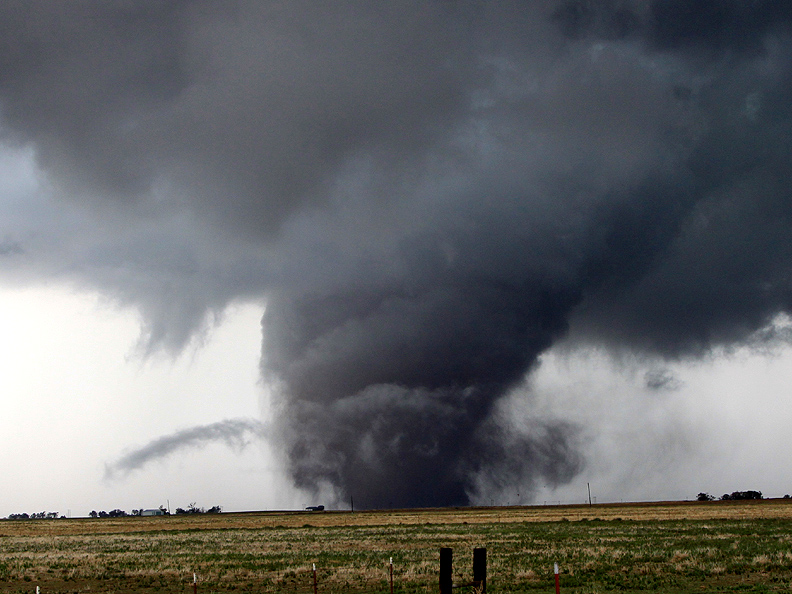Tornado Alley: Where Twisters Form
Tornado Alley is term that it is typically used to describe a wide swath of tornado-prone areas between the Rocky Mountains and Appalachian Mountains that frequently experience tornadoes. It is not an official weather term; it was primarily a phrase popularized by the media.
Where is Tornado Alley?
The borders of Tornado Alley are not clearly defined. They vary, depending on the criteria used — frequency, intensity, or events per unit area. Generally, a Tornado Alley map starts in central Texas and goes north through Oklahoma, central Kansas and Nebraska and eastern South Dakota, sometimes dog-legging east through Iowa, Missouri, Illinois and Indiana to western Ohio.
While the "Wizard of Oz" still conjures up images of Kansas as a tornado-prone area, that state is not the most highly impacted state when it comes to tornadoes. According to the National Climatic Data Center, Texas reports the highest number of tornadoes of any state, although its very large land mass accounts for that status. Kansas and Oklahoma are second and third respectively when it comes to the number of tornadoes reported, but those states report more tornadoes per land area than Texas.
Convergence of conditions
Tornado Alley has all of the weather conditions needed for a tornado to take shape. Tornadoes form when three different types of air converge in a specific manner: a layer of warm and humid air near the ground along with strong southerly winds; colder air along with strong west or southwest winds line the upper atmosphere; and a third layer of very warm dry air that hovers between the warm and moist air at low levels and the cool dry air above.
While not as familiar as Tornado Alley, the designation Dixie Alley generally refers to another part of the country that is likely to experience tornadoes — generally the upper Tennessee Valley and Lower Mississippi Valley.
Get the world’s most fascinating discoveries delivered straight to your inbox.
Florida’s almost daily thunderstorms spawn a large number of tornadoes, designating it as the state with the with the highest number of tornadoes per square mile. However, a relatively small percentage of Florida’s tornadoes are considered high intensity.
Globally, latitudes between about 30 degrees and 50 degrees North or South provide the most favorable environment for tornadoes. The United States records about 1,000 tornadoes a year, by far the most prolific of any region in the world, with Canada ranking second at only 100 per year. [Related: 12 Twisted Tornado Facts]
Origin of the term
The first use of the term "Tornado Alley" can be traced to 1952. It was the title of a research project by U.S. Air Force meteorologists Major Ernest J. Fawbush and Captain Robert C. Miller. They coined the term as part of their study of extreme weather events in an area from Lubbock, Texas, to Colorado and Nebraska. Fawbush and Miller were no strangers to the study of twisters, as they have been credited with making the first successful tornado forecast in 1948 and setting off the first official tornado warning in modern times.
The phrase took hold in the media and gained traction. “Tornado Alley” was the headline of a "New York Times" article published on May 26, 1957, documenting some of the country’s recent tornado activity. The article began: “According to the U.S. Weather Bureau, tornadoes have occurred in every hour of the day, every month of the year, and in every state. But most often they occur in May and June, between 4 and 7 p.m., in what has been called ‘Tornado Alley’ — Texas, Oklahoma, Arkansas, Missouri and Iowa.”
Ten deadliest tornadoes
| Date | Intensity | States affected | Deaths |
| March 18, 1925 | F5 | MO, IL, IN | 695 |
| May 6, 1840 | Unknown | LA, MS | 317 |
| May 27, 1896 | F4 | MO, IL | 255 |
| April 5, 1936 | F5 | MS | 216 |
| April 6, 1936 | F4 | GA | 203 |
| April 9, 1947 | F5 | TX, KS, OK | 181 |
| May 22, 2011 | EF5 | MO | 158 |
| April 24, 1908 | F4 | LA, MS | 143 |
| June 12, 1899 | F5 | WI | 117 |
| June 8, 1953 | F5 | MI | 116 |
Source: National Climatic Data Center
Kim Ann Zimmermann is a contributor to Live Science and sister site Space.com, writing mainly evergreen reference articles that provide background on myriad scientific topics, from astronauts to climate, and from culture to medicine. Her work can also be found in Business News Daily and KM World. She holds a bachelor’s degree in communications from Glassboro State College (now known as Rowan University) in New Jersey.



